So this week’s recipe was chosen because I leafed through Mary’s’ notebook looking for something where I understood what all the ingredients were, and I understood what the end result was. These are, after all,the early days of this project and I thought this would be a bit of stretching and limbering up before tackling the trickier cakes and tarts to come.
So I thought, and I thought this because I didn’t carefully think about the list of the ingredients and what they meant.
This is Mary’s recipe: I halved the amounts and converted to metric and came up with this:
-
450g flour
120g butter
170g castor sugar
120g currants
1.5 tsp cream of tartar
0.5 tsp bicarbonate of soda
500ml buttermilk (but see below…)
For the icing:
-
2 lemons
enough icing sugar to make up your preferred thickness of icing – I used about 250g
and here’s what I did to make it up:
-
Set your oven to 180C
Cream together the butter and sugar.
Add buttermilk to the bowl and mix.
Sieve together the flour, cream of tartar and bicarb.
Mix the flour into the buttermilk mixture, a spoon at a time.
Stir in the currants
Set on a baking sheet and bake for 20mins
Allow to cool and then pour/spoon over the icing.
Now here’s the problem: what is this supposed to be? You’ll see from the picture above that the same recipe is used to make ha’penny buns. I could have sworn that every single book I read as a child contained at least one reference to ha’penny buns, but it is difficult to find much out on the internet about them. In my head they were always a lot like hot-cross buns; shiny and brown and risen. I don’t imagine that there was a law that every single type of bun sold for half-a-penny was exactly the same, but I thought that maybe a convention had arisen that a ha’penny bun was a certain sort of thing, and that that thing was a yeasted bready thing. I looked in Elizabeth David’s English Bread and Yeast Cookery, Eliza Acton’s Modern Cookery, Dorothy Hartley’s Food in England,and Jane Grigson’s English Food and not one of them had a recipe for something called a bun that didn’t involve yeast.
Alternatively, I thought, aren’t those fairy cake tins called ‘bun tins’? Perhaps this should be more of a cakey thing… but then look at the quantity: you’re supposed to get 17 from a mixture including 2lb of flour. It’s certainly not a little tiny thing, these are quite hefty whatever this is.
Now look at the ingredients: no egg, so not really a cakey thing, no yeast, so not really a bready thing. In fact if you look for recipes with similar ingredients, the closest you will get is scones. I started down a cakey sort of route, and thought I’d add buttermilk to the butter and sugar till I got to the sort of consistency I might expect from eggs in a cake recipe. This was the result after I’d added about two thirds of the flour:
That mixer is not leaning against the back of the bowl, it is standing up in the dough. I worried that this might be a little stiff for what I was trying to do, so I added quite a bit more buttermilk (this ‘more’ is already included in the amount given above).
(This might be a good place to note that just because I am baking recipes from the first half of the 20th century does not mean I am using their technology too. There were four sisters, after all, and there’s only me.)
So by the end the dough is quite sloppy – I put it on the baking sheet:
I cannot pretend I am thrilled with the results here: the things hardly rise at all. What do they taste like? Well, a bit like a scone, to be honest. Better than many items of confectionary I’ve bought in the past but not something I’m desperate to bake again or would recommend that you try. Also, another thing to notice is that these are called ‘Lemon Buns’ but the only lemony bit is when you get to the icing right at the end, and yet that’s still right. Lemon icing is brilliant, and I’m glad I made these if only to remind me of that.
Perhaps in the the distant future I will get round to a second attempt at recipes I wasn’t very happy with last time. If I do, what I will change next time round is that I’ll use less buttermilk so that this is more like a scone dough.
Meanwhile perhaps this wasn’t such a bad place to start on the project after all: it’s taught me that one of the things I need to keep a close eye on is that I understand what I’m trying to make in the first place, so that I can compare to other similar recipes. This article also makes the distinction I talked about in my last post about how you can improvise in cooking but not in baking, and adds some useful rules of thumb for baking recipes. The other thing this teaches me is how I’ll never really get back to what was really baked in the bakery in Hollins Road – this week I’ve found out a few things about ingredients for future recipes that I thought I’d never find out, and I’ve learnt a couple of things about some of the cakes that we’ll come to in the future. But I’m stumped by something simple called ‘Lemon Buns’ because I don’t really know what it could have been. It’ll be fun getting as close as we can though.
(Edited to add name of recipe to the title)
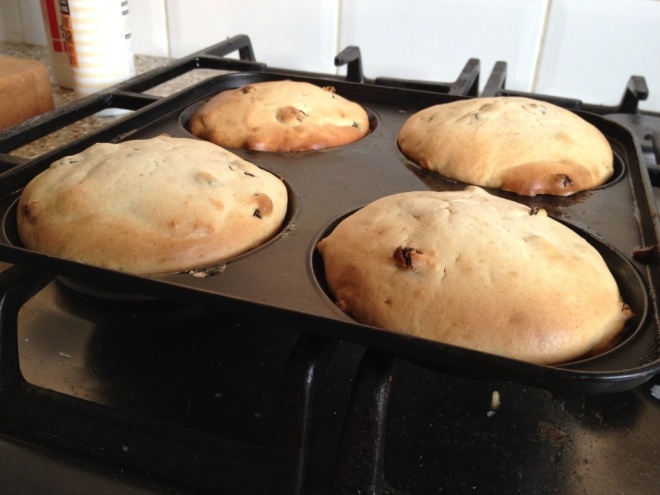
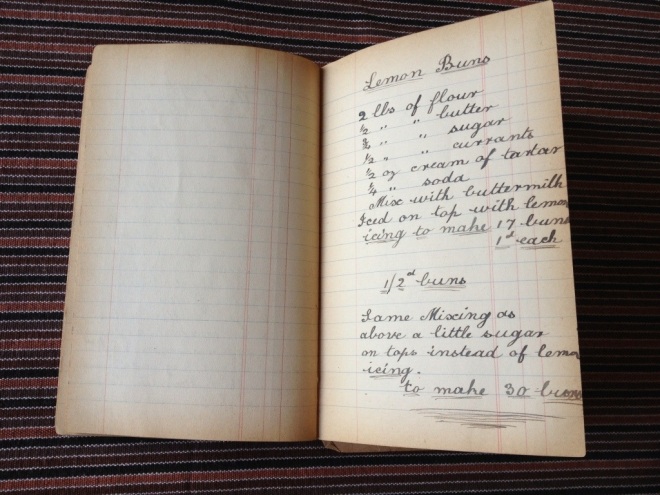
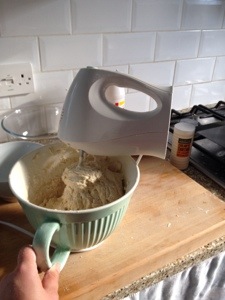
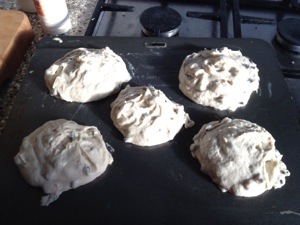
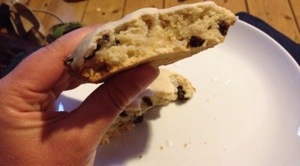
Pingback: Child’s play: Cocoa nut Buns | Nikki flippin' Coates